Wines That Have Recently Captured Our Attention: Seven Gestures By Seven Thoughtful Producers In The Loire And The French Mediterranean (7-Bottle Pack $269)
I’ve always imagined that one of the great pleasures (and challenges) of owning an art gallery is mounting significant shows—exhibitions that represent a relevant theme, whether it is showcasing new talent, topical issues or illustrating cross-cultural interpretations of a similar subject. And yet, I’ve discovered that running a wine shop offers the same opportunity for thematic expression, and like the gallery owner, I am able to provide a forum for younger wine makers using innovative new techniques. I can tackle climate change as it relates to wine and compare how different appellations treat the same grape varieties.
This week’s exhibit features seven wines that have left a lasting impression on me; they are unique examples of wines whose central theme is an expression of ‘living fruit’. This often includes a purist approach to processes (or lack thereof) in order to coax as much clarity from their terroir’s inherent potential. It may involve declassifying lots in order to avoid the red tape of appellation laws; it may the result of pesticide-free farming to exploit a vineyard’s total ecosystem, and it may simply be an experiment gone right. But they are all the work of passionate winemakers who view the earth as a toolbox of possibility. Each of these wines has common denominators as well as individual styles; they are pictures at an exhibition intended to drive dialogue, an exchange of ideas and interpretations while celebrating a common cause.
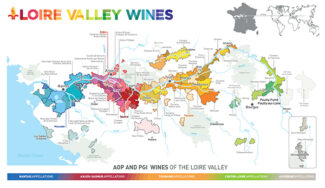
The Loire Valley
Château de Fosse-Sèche (Anjou-Saumur)
If a single concept can describe the most profound change that has seized modern European winemaking, it is biodynamics—techniques that their forebears may have practiced by necessity without naming it, but which today is a nod to the cosmic continuum of which agriculture is only a part. Nowhere is this visionary approach more conspicuous than at Château de Fosse-Sèche, where twin brothers Guillaume and Adrien Pire (who grew up in Madagascar) bring with them not only degrees in agronomy and viticulture, but a deep respect for the wild land of their youth. Along with their wives Julie and Cécile, they have instilled Fosse-Sèche’s 800-year history with an abiding belief in a holistic remake of all phases of winemaking.
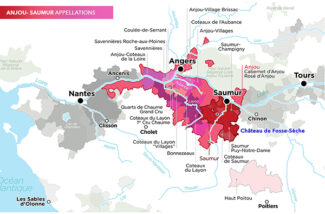
Like an iron-red ruby amid the seafoam of limestone, the soils of Fosse-Sèche are rather unique in the Loire—a fact that has been recognized since the 13th century, when Benedictine monks first planted vines there. Move the clocks ahead to 1998, when the Keller-Pire family took over the estate, enraptured by the beauty of the surroundings and its exceptional terroir, composed of iron oxide and flinty silex just beneath the topsoil. Two-thirds of the Fosse-Sèche property is a natural reserve, with a bird sanctuary, acres of honey flowers, goats and thriving wetlands; of the hundred eleven acres of property, only 37 are used for vines. The single parcel is planted to Cabernet Franc (70%) and Chenin Blanc (30%).
Hélène Berteau, a beekeeper, also tends hives on the estate and benefits directly from everything that is done for the ecosystem. Guillaume Pire says, “We maintain between 2 and 5.5 hectares (5 and 13.5 acres) of pollen fallow. The logic of this mixture: Bee plants attract pollinating insects and legumes fix nitrogen from the air. These plants loosen and aerate the soil, attract auxiliary insects (ladybugs, butterflies, etc.) and release seeds for birds. The deficiency of pollen and nectar is an important factor in the gradual extinction of populations of bees and other pollinating insects. These flowers are also shelters and potential sources of food for wildlife thanks to this richness in insects.”
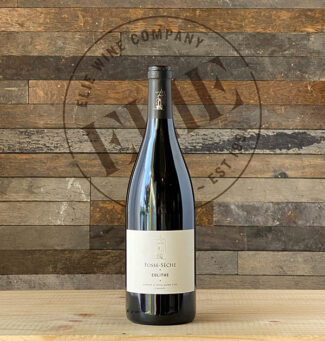 Fosse-Sèche ‘Eolithe’ 2019 VdF Loire Rouge ‘natural’ ($39)
Fosse-Sèche ‘Eolithe’ 2019 VdF Loire Rouge ‘natural’ ($39)
‘Eolithe’ is the geological name for the iron-sprinkled flint that forms the winery’s amazing soil structure. Relatively low in alcohol for a fully ripened Cabernet Franc (12.5%), the wine is rich with a sense of purple; purple flowers (violets) and purple fruits like plums and blackberries; a piercing spine of acidity keeps the flavors lively and promises potential for tomorrow and tomorrow and tomorrow—if you don’t drink it tonight.
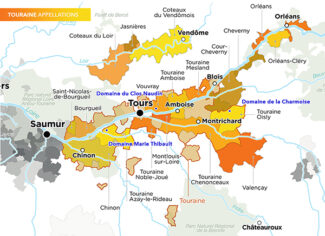
Domaine Marie Thibault (Touraine Azay-le-Rideau)
“I grew up in the Loire Valley, but unlike many vignerons working in the Loire, I did not come from a winemaking family,” says Marie Thibault, adding, “But also unlike many of them, I have degrees in both biology and oenology.”
Marie Thibault began making wine in the early 2000s, working for a time with François Chidaine in Montlouis, where she fell in love with Chenin Blanc. In 2011, she founded her own nine-acre estate on a single windy slope in Azay-le-Rideau, a lesser known commune of Touraine. She immediately converted to organics and has been certified with Ecocert since 2014. Among the natural elements in her vineyards is the flock of two dozen ewes that graze between the vine rows during the autumn; every ten days, they are penned inside a new hectare to keep the soil naturally fertile and the grass clipped.
“My vineyard is small, but the soils are extremely varied and as such, so are the grapes I grow. I work with Côt (Malbec), and have a special love for Gamay, Grolleau, Chenin Blanc and Sauvignon Blanc. Most of my vines are at least 50 years old. I compensate for small production by purchasing from organic estates nearby, especially Noëlla Morantin and Frantz Saumon—who also happens to be my life partner.”
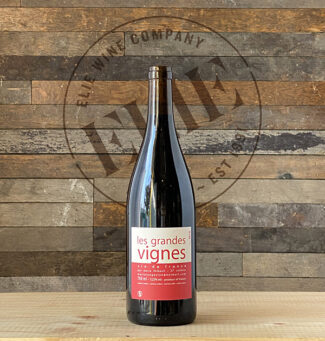 Domaine Marie Thibault ‘Les Grandes Vignes’, 2018 VdF Loire ‘Gamay’ Rouge ‘natural’ ($41)
Domaine Marie Thibault ‘Les Grandes Vignes’, 2018 VdF Loire ‘Gamay’ Rouge ‘natural’ ($41)
Thibault’s unique lens on Gamay is seen in this example produced from 50+ year-old vines she discovered growing adjacent to her plot on flinty silex soil. The vines were untrained and un-trellised, and harvest was exceptionally labor-intensive. She allows a 10-month maceration in order to shows off the Gamay’s savory side, with crisp rhubarb, earthy red berry notes and fine-grained, well-integrated tannins showcased.
Domaine de la Charmoise (Touraine)
One of the more noteworthy ironies in this selection is that Domaine de la Charmoise nestles deep with the forests of La Sologne, home to the great Limousin oak trees that makes the best of French wine barrels.
… And the Marionnets, father Henry and son Jean-Sébastien, eschew wood as ‘unnatural’ in their winemaking process.
The family has owned the estate since the mid-19th century and unlike many of their counterparts in France, they kept control throughout the 20th century and now, well into the 21st, they are going strong. Nearly all the vineyards were replanted and enlarged between 1967 and 1978 and most of the wines are produced from vines more than 30 years old. Although these focus on Gamay and Sauvignon Blanc, the Marionnets also produce wines from varieties not found elsewhere in the world. ‘Provignage’ is produced from Romorantin, an extremely rare variety, and the Cépages Oubliés from an almost obsolete clone of Gamay de Bouze.
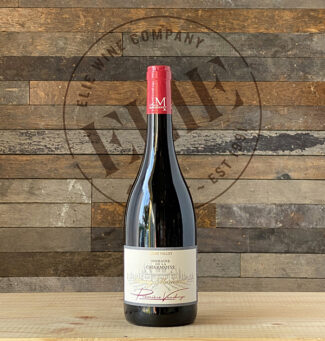 Domaine de la Charmoise ‘Première Vendange’, 2021 Touraine ‘natural’ ($24)
Domaine de la Charmoise ‘Première Vendange’, 2021 Touraine ‘natural’ ($24)
Touraine’s best terroir for Gamay and Sauvignon Blanc is referred to as ‘perruches’—French for ‘parakeets.’ It is composed of flinty clays combined with silica, which warms up quickly in the spring and in the wine, leaves pronounced minerality. That’s evident in the Marionnets’ ‘Première Vendange’—100% Gamay bottled without sulfur. Beyond the flinty backbone, it is silky smooth with a concentrated purity, showing pretty aromas of sweet red berries, vibrant tart cherry and blueberry on the palate and a refreshing acidity on the finish.
Domaine du Clos Naudin (Vouvray)
Philippe Foreau is the third generation of the Foreau family to produce Vouvray from the land his grandfather purchased in 1923. The vineyards are located in the northeast corner of Vouvray, situated mid-hill with south/southeast/southwest exposures. The principal vineyards are known as ‘Les Perruches’ and ‘Les Ruettes’, where the average age of the vines is 45 years. Although he produces sensational sparkling wine, Foreau is one of the few producers in Vouvray to put more emphasis on his still wines, using techniques that emphasize the purity of the fruit while paying almost superhuman attention to detail, creating oak-free white wines that improve immeasurably with age.
“We do not seek to rely on additives; we prefer to work with what each vintage’s weather gives us,” says Foreau. “This means no chaptalization and as such, in some years, only secs will be made, while in other years, still quite unusual, there will be the full range. We always bottle in the spring following the vintage to preserve the fruit and their freshness, which may still be quite evident after several years of aging.”
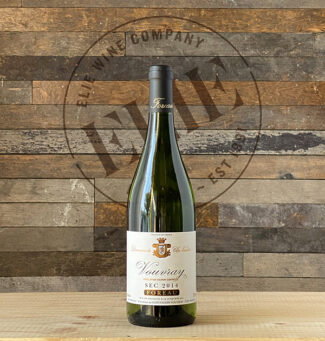 Domaine du Clos Naudin, 2014 Vouvray Sec ($49)
Domaine du Clos Naudin, 2014 Vouvray Sec ($49)
A classic Chenin Blanc combining confident exuberant fruit with riveting acidity. As the first winemaker in Vouvray to press pneumatically, Foreau’s juice is first pressed, and then run into 300-liter barrels for fermentation on indigenous yeasts. A purist’s dream, with no chaptalization, no tangible use of new oak, minimal use of sulfur dioxide and no malolactic fermentation due largely to the low temperatures in the cellars. It has fully matured and the aromatics remain wonderfully clean, with scents of orange citrus, lemon balm and smoky mineral streaks.
Domaine du Bouchot (Pouilly-Fumé)
Domaine du Bouchot is a tiny property in St. Andelain in the southern part of Pouilly Fumé, close to the Loire River, and run by Rachel and Pascal Kerbiquet who describe themselves as ‘organic activists.’
In 1985, the couple planted two plots on old farmland that once specialized in wheat, but where the Kimmeridgian limestone soil was ideal for vines. Facing southwest, the two plots—the ‘Côte des Pres’ and ‘Fouinelles’ vineyards—are now 35 years old. In 1995, they planted two more parcels, ‘Vaurigny’ and ‘Papillons’, on Portlandian soils.
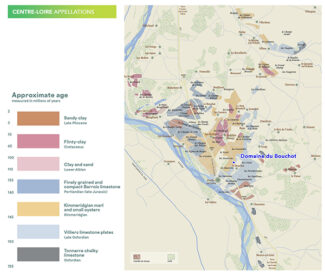
Says Pascal, “Rachel and I have always been about the ecology of the estate foremost. We were the first domain in the appellation to become certified organic and remain one of the only domains in the appellation working biodynamically. Soils are plowed by horse; leaf plucking normally takes place in the summer to allow more maturity for our Sauvignon Blanc. The harvest is always done by hand; the yeasts are indigenous to our cellars and the wine is made with as little pumping as possible, then bottled in the spring after a very light filtration.”
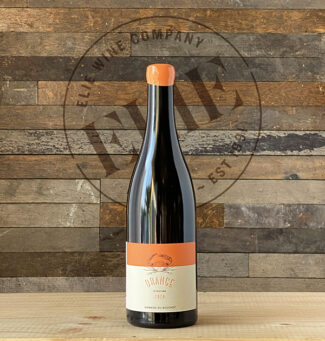 Domaine du Bouchot ‘Orange’, 2020 VdF Loire Blanc ‘natural’ ($48)
Domaine du Bouchot ‘Orange’, 2020 VdF Loire Blanc ‘natural’ ($48)
‘Orange’ wine, of course, refers to its color, not its place of origin. It’s an ancient technique as well as a current fad—white wine produced from white grapes (in this case Sauvignon Blanc) that have been allowed prolonged skin and stem contact, thereby extracting the characteristic amber tint and a unique flavor profile, which often involves slight oxidation. Bouchot’s example shows nutty, smoky red currant, lime zest and briary nettle—its aromatic pungency coincides with a silken-textured, very pure palate.
The French Mediterranean
Clos de la Barthassade (Languedoc-Roussillon, Terrasses du Larzac)
Officially recognized in 2014, the red wine appellation of Terrasses du Larzac encompasses 32 communes scattered among the foothills of Larzac with its northern boundary formed by the Causse du Larzac. Impressed by the terroir of Larzac, which includes pronounced diurnal temperature variation due to the proximity of the southern Massif Central, Hélène and Guillaume Baron settled here after careers spent in Burgundy; Hélène in Marsannay and Guillaume in Volnay and Saint-Aubin.
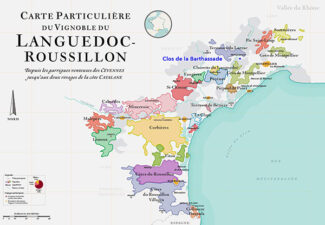
In Larzac, they purchased 24 acres of old-vine Syrah, Grenache Noir, Cinsault, Mourvèdre, and Chenin Blanc in various prime spots in the villages of Montpeyroux, Jonquières, and Saint Saturnin. They named their domain ‘Clos de la Barthassade’ in honor of the local word for scrub-brush, ‘bartàs’; and refers to the thick wood bordering their vineyards in Montpeyroux. From the start, the couple farmed organically, and these days, about half of their acres are cultivated according to biodynamic practices. The oldest parcels of bush-vines are particularly pampered and are ploughed carefully with a horse. It is these techniques, coupled with superb terroir, which results in wine exuding freshness and aromatic expression. And this is evident most emphatically in their Carignan—a varietal they love: “Carignan is a sensitive variety,” Hélène maintains. “It does better if the grapes do not receive direct sunlight. So, we maintain each vine stock with a parasol of leaves as a shield; this is made easier by Carignan’s natural tendency to droop, but the time saved is spent de-budding and removing intercores in order to keep the fruit well-ventilated.”
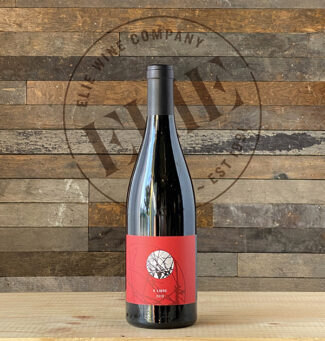 Clos de la Barthassade ‘K Libre – Carignan’, 2019 VdF Languedoc-Hérault Rouge ($39)
Clos de la Barthassade ‘K Libre – Carignan’, 2019 VdF Languedoc-Hérault Rouge ($39)
The sun-soaked terraces of Montpeyroux provide vines plenty of heat throughout the growing season, allowing the grapes to reach optimal maturity with just the right amount of stress to provide depth and concentration; this is the Baron’s prized terroir and they find it particularly suited to Carignan. ‘K Libre’ offers a savory crunch with crushed violets, wild herbs, graphite and cassis on the nose and an ideal balance of girth and finesse in the mouth.
Clos Marfisi (Corsica)
Corsica nestles in the Mediterranean Sea between the southeast coast of Provence and the west coast of Tuscany. Although it is closer to Italy, Corsica has been under French rule since 1769 and is counted among the 26 regions of France. Still, the island’s Italian origins shine through in its wines, which are made predominantly from Vermentino and Sangiovese (known here as Rolle and Niellucciu). The north-central AOP of Patrimonio covers around a thousand acres, and about half is managed by Corsica’s two biggest producers. The other half is scattered among dozens of smaller winemakers and among them is Mathieu and Julie Marfisi, representing the fifth generation at the helm of Clos Marfisi.
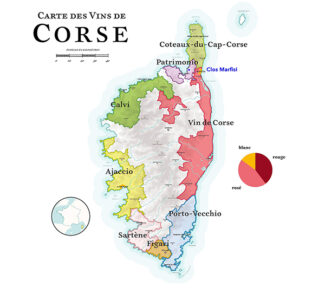
Clos Marfisi’s vineyards were planted almost half a century ago (and strictly to local varieties) by Toussaint Marfisi. Today, they rise from the sea with southern and western exposures. The steep slopes are riddled with large chunks of shattered limestone, forming Corsica’s unique, calcium-rich terroir. Says Mathieu (who is also president of the Patrimonio AOP), “Our father is still very active in the vineyards, and is the main reason that this estate has never been touched by pesticides or herbicides,” which were shunned for one reason or another by previous generations of vignerons on the island. This commitment to organics continues and the estate was certified Bio at the 2018 vintage. Vestiges of the old guard remain in the cellar as well where native yeasts have always been used for fermentations, and sulfur levels are kept to a minimum.
Julie explains the ‘new guard’ philosophy: “When he managed the domain, my father made a white, a red and a rosé, period. There were no such notions of plots; he made wine, that’s all. From now on, every year, my brother and I have the experience of developing a new cuvée!”
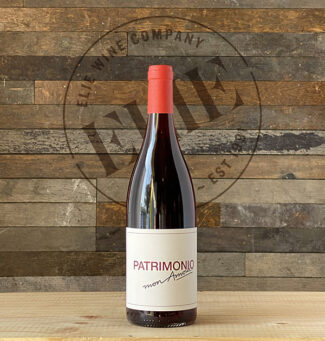 Clos Marfisi ‘Mon Amour’, 2020 Patrimonio Rouge ‘natural’ ($29)
Clos Marfisi ‘Mon Amour’, 2020 Patrimonio Rouge ‘natural’ ($29)
Believed to be a nearly-identical clone of Sangiovese, the Niellucciu grape is nonetheless indigenous to Corsica and produces a red wine light in color (darkish pink, like the rosés of Tavel) and in a style referred to as ‘glou-glou’—meant to simulate the sign of chugging a liquid. Glou-glou wines tend to be so refreshing and quaffable that they spend less time in the bottle than they do being poured into an empty glass, and in the Marfisi’s version, a crackling texture and zesty notes fresh red fruit opening slowly to offer plums, exotic spices and ripe, firm tannins. Serve slightly cold.
Notebook …
The Gesture of Being ‘Natural’: All About the Fruit
In wine, ‘natural’ is a concept before it’s a style. It refers to a philosophy; an attitude. It may involve a regimen of rituals or it may be as simple as a gesture, but the goal, in nearly every case, is the purest expression of fruit that a winemaker, working within a given vineyard, can fashion. Not all natural wines are created equal, and some are clearly better than others, but of course, neither is every estate the same, nor every soil type, nor each individual vigneron’s ideology.
The theory is sound: To reveal the most honest nuances in a grape’s nature, especially when reared in a specific environment, the less intervention used, the better. If flaws arise in the final product—off-flavors, rogue, or ‘stuck’ fermentation (when nature takes its course), it may often be laid at the door of inexperience. Natural wine purists often claim that this technique is ancient and that making wine without preservatives is the historical precedent. That’s not entirely true, of course; using sulfites to kill bacteria or errant yeast strains dates to the 8th century BCE. What is fact, however, is that some ‘natural’ wines are wonderful and others are not, and that the most successful arise from an overall organoleptic perspective may be those better called ‘low-intervention’ wine, or ‘raw’ wine—terminology now adopted by many vignerons and sommeliers.
At its most dogmatic and (arguably) most OCD, natural wines come from vineyards not sprayed with pesticides or herbicides, where the grapes are picked by hand and fermented with native yeast; they are fined via gravity and use no additives to preserve or shore up flavor, including sugar and sulfites. Winemakers who prefer to eliminate the very real risk of contaminating an entire harvest may use small amounts of sulfites to preserve and stabilize (10 to 35 parts per million) and in natural wine circles, this is generally considered an acceptable amount, especially if the estate maintains a biodynamic approach to vineyard management.
In all things wine, ‘balance’ is a key to the kingdom; it is a term interchangeable with harmony, and may reference acid, alcohol level, grape sugars and tannin, but also, to a scale in which the long-term health of the product is considered along with the flavors inherent on release. More than just a current radar blip in trendy social capital a naturalistic approach to winemaking is not only more honest, but better for a sustainable environment: It’s a nod to the past and a gesture to the future.
Vin de France (VdF) Designation: Free the Winemaker
Wines in France are classified into one of three categories: AOP (Appellation d’Origine Protegée, formerly AC), IGP (formerly Vin de Pays) and Vin de France. AOP wines are identified only by the names of their appellations, usually without varietal descriptions; the next level, IGP, comes from broader regions, and may be identified by varietal names; and the lowest level has no indication of origin at all.
Vin de France is a catch-all. Produced often at high yields, most Vins de France are low-priced, but hidden within them are top wines, pushed out of the appellation system, that can be every bit as good as the best in the AOP. They can be hard to identify, because origins aren’t obvious – many indicate only the names of producer and cuvée – and while they may seem expensive for this lowly category, they can offer remarkable interest. With only a few high-flying Vins de France, this is a small class, but it’s well worth investigating.
- - -
Posted on 2022.09.20 in Saumur-Champigny, Touraine, Anjou, Pouilly-Fumé, Vouvray, Terrasses du Larzac, Patrimonio, France, Wine-Aid Packages, Languedoc-Roussillon, Loire, Corsica
Featured Wines
- Notebook: A’Boudt Town
- Saturday Sips Wines
- Saturday Sips Review Club
- The Champagne Society
- Wine-Aid Packages
Wine Regions
Grape Varieties
Aglianico, Albarino, Albarín Blanco, Albarín Tinto, Albillo, Aleatico, Arbanne, Aubun, Barbarossa, barbera, Beaune, Biancu Gentile, bourboulenc, Cabernet Franc, Cabernet Sauvignon, Caino, Caladoc, Calvi, Carcajolu-Neru, Carignan, Chablis, Chardonnay, Chasselas, Clairette, Corvina, Cot, Counoise, Erbamat, Ferrol, Fiano, Frappato, Friulano, Fromenteau, Fumin, Garnacha, Gewurztraminer, Godello, Graciano, Grenache, Grolleau, Groppello, Juan Garcia, Lambrusco, Loureira, Macabeo, Macabou, Malvasia, Malvasia Nera, Marsanne, Marselan, Marzemino, Melon de Bourgogne, Merlot, Mondeuse, Montanaccia, Montepulciano, Morescola, Morescono, Moscatell, Muscadelle, Muscat, Natural, Nero d'Avola, Parellada, Patrimonio, Petit Meslier, Petit Verdot, Pineau d'Aunis, Pinot Auxerrois, Pinot Blanc, Pinot Gris, Pinot Meunier, Pinot Noir, Poulsard, Prieto Picudo, Rondinella, Rousanne, Roussanne, Sangiovese, Sauvignon Blanc, Savignin, Semillon, Souson, Sparkling, Sumoll, Sylvaner, Syrah, Tannat, Tempranillo, Trebbiano, Trebbiano Valtenesi, Treixadura, Trousseau, Ugni Blanc, vaccarèse, Verdicchio, Vermentino, Viognier, Viura, Xarel-loWines & Events by Date
- April 2024
- March 2024
- February 2024
- January 2024
- December 2023
- November 2023
- October 2023
- September 2023
- August 2023
- July 2023
- June 2023
- May 2023
- April 2023
- March 2023
- February 2023
- January 2023
- December 2022
- November 2022
- October 2022
- September 2022
- August 2022
- July 2022
- June 2022
- May 2022
- April 2022
- March 2022
- February 2022
- January 2022
- December 2021
- November 2021
- October 2021
- September 2021
- August 2021
- July 2021
- June 2021
- May 2021
- April 2021
- March 2021
- February 2021
- January 2021
- December 2020
- November 2020
- October 2020
- September 2020
- August 2020
- July 2020
- June 2020
- May 2020
- April 2020
- March 2020
- February 2020
- January 2020
- December 2019
- November 2019
- October 2019
- September 2019
- August 2019
- July 2019
- June 2019
- May 2019
- April 2019
- March 2019
- February 2019
- January 2019
- December 2018
- November 2018
- October 2018
- September 2018
- August 2018
- July 2018
- June 2018
- May 2018
- April 2018
- March 2018
- February 2018
- January 2018
- December 2017
- November 2017
- October 2017
- September 2017
- August 2017
- July 2017
- June 2017
- May 2017
- April 2017
- March 2017
- February 2017
- January 2017
- December 2016
- November 2016
- October 2016
- September 2016
- August 2016
- July 2016
- June 2016
- May 2016
- April 2016
- March 2016
- February 2016
- January 2016
- December 2015
- November 2015
- October 2015
- September 2015
- August 2015
- July 2015
- June 2015
- May 2015
- April 2015
- March 2015
- February 2015
- January 2015
- December 2014
- November 2014
- October 2014
- September 2014
- August 2014
- July 2014
- June 2014
- April 2014
- March 2014
- February 2014
- January 2014
- December 2013
- November 2013
- October 2013
- September 2013
- August 2013
- July 2013
- June 2013
- May 2013
- April 2013
- March 2013
- February 2013
- January 2013
- December 2012
- November 2012
- October 2012
- February 2004
Search



